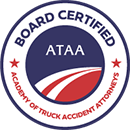Head-On Collisions
Among the different types of truck collisions, head-on collisions might be among those considered the most dangerous. Data previously published by the Federal Motor Carrier Safety Administration (FMCSA) suggests that at least 4,000 head-on truck accidents occur annually here in the U.S., an amount that equates to 3% of all tractor-trailer crashes. Additional statistics published by the Insurance Institute for Highway Safety (IIHS) show that in 2020, at least 30% of passenger car drivers who lost their lives in big truck-involved crashes did so in head-on collisions.
If you or someone you love has been involved in a head-on collision with a large truck or commercial vehicle, contacting a head-on truck accident lawyer from Trucking Injury Law Group can grant you peace of mind. With our help, you may be able to secure a legal claim against a trucker or trucking agency that acted wrongfully.
Common Causes of Head-On Truck Collisions
Some of the same factors, including the following, that may result in a passenger car driver colliding head-on into another similarly sized vehicle also often result in a tractor-trailer and smaller automobile (like a sedan) having a front-end crash:
- Medical conditions: Truckers must undergo U.S. Department of Transportation (DOT) physicals to ensure they’re healthy enough to safely operate a vehicle as large and heavy as a tractor-trailer for an extended period of time on the road. Unfortunately, like most individuals, a trucker’s health status may deteriorate over time, especially given their poor diet, sedentary lifestyle, and stressors associated with their job, leaving them vulnerable to having an adverse medical event that sends them careening into oncoming traffic, striking a passenger car driver’s vehicle head-on in the process.
- Speeding: Driving at a fast rate of speed leaves truckers vulnerable to completely losing control of their tractor-trailers. When a truck driver crosses a center line and median, it can leave them vulnerable to colliding head-on with motorists in oncoming traffic.
- Distracted driving: Distracted truck drivers, or ones who are texting and driving, eating, or conversing with others while behind the wheel, are dangerous. They can easily become so engaged in what they’re doing aside from driving that they end up ignoring traffic devices (like red lights or stop signs) or leave their lane, traveling head-on into other vehicles.
- Truck driver inexperience: It matters how long drivers have been on the road, and this logic applies to truckers too. Experience dictates how sound their judgment may be when deciding to travel into oncoming traffic temporarily to pass other vehicles on a 2-lane road or how they steer when confronted by a scenario in which they take a chance and temporarily move into head-on traffic in an attempt to avoid striking wildlife that runs out in front of them.
- A lack of familiarity with the area: It can be challenging navigating a new area. It may result in a trucker turning down a one-way road when they shouldn’t or lead them to pull into an oncoming traffic lane, becoming entangled in a wrong-way crash.
- Mechanical issues: Truck drivers have an obligation to perform a multi-point inspection to confirm that their 18-wheelers are mechanically sound or roadworthy before heading out on the road. A blown tire, poorly aligned truck, and other mechanical flaws could send a trucker into the direction of an oncoming vehicle, putting its occupant at risk of getting hurt.
- Drugged or drunk driving: Substance abuse can impair a trucker’s safe operation of their 18-wheeler, causing them to deviate outside of their lane and crash into the front end of another motorist’s automobile.
- Poor lighting: This may refer to either poorly illuminated entrances to parking lots, at intersections, along stretches of rural highways, or around on-bound interstate ramps, all of which can make it challenging for a trucker to see what lies in their path ahead. Additionally, it can refer to a tractor-trailer operator that fails to turn on their headlights or has non-functioning ones.
- Drowsy driving: A trucker that is tired from being overworked because they don’t get in required truck driver breaks and rest on off days can fall asleep at the wheel of their semi-truck. Driver fatigue can lead to a trucker crossing a double yellow line on a 2-lane road or median, ending up with the two vehicles’ front ends colliding with each other.
- Weather-related factors: Fog, heavy rain, and snow are a few examples of weather scenarios that can make it challenging for commercial truck drivers to see where they’re traveling, leaving them more vulnerable to venturing out of their lanes into oncoming traffic or making a wrong-way turn.
- Making too wide of turns: If you’ve ever watched a trucker make a turn, you’ve likely seen how their tractor-trailers seldom, if ever, avoid spilling over into adjacent lanes. The necessity to make wide turns leave drivers vulnerable to crashing head-on into passenger cars nearby.
While this list describing the reasons why head-on truck collisions occur is far from comprehensive, it hopefully gives you an enhanced perspective as to some of the reasons these accidents occur.
Head-On Truck Accident Injuries
Our bodies have a tendency to be propelled forward during head-on crashes. That’s essentially why all passenger cars come equipped with front-impact airbags nowadays. The role of the airbag is to try to keep vehicle occupants safely inside their vehicles and to limit the impact of occupants’ heads and chests against interior structures. It wasn’t uncommon for head-on collisions to result in front seat passenger car occupants’ ejections before the existence of airbags.
Despite the fact that most newer vehicles have airbags, not everyone has such an automobile, nor do airbags always reliably deploy as they should. Additionally, the force of the impact of an airbag can cause harm to vehicle occupants. Thus, in terms of injuries that can result in head-on collisions with trucks, the following ones may occur:
- Burns: This can be caused by the deployment of the airbag or any front-end fire that ignites with crash impact
- Broken bones: These injuries may happen with the force of the airbag when it deploys or if there isn’t one
- Blunt force trauma: This may be caused by a passenger car occupant’s head or another body part striking the dashboard or exterior of another car
- Road rash: This can stem from an ejected motorist’s body making contact with the ground
- Impaling types of head injuries: This type of injury may stem from a person’s head crashing through the windshield and glass becoming dislodged in their brain or skull, which, even if removed, can leave a victim with traumatic brain injuries
- Compression injuries: These may stem from the passenger compartment becoming compromised, leaving a car’s frame to tighten or trap occupants or their body parts inside for a prolonged amount of time, restricting normal blood flow and muscular functioning
- Neck injuries: Any force that causes a sudden movement of our heads and necks forward has the potential to leave us with soft tissue injuries in that region, like whiplash
- Spinal cord injuries: The positioning of an impact may determine whether a truck injury victim’s spinal cord gets severed, causing them partial or complete paralysis
- Amputations: The crushing impact of a head-on truck crash may be so significant that it splinters bones and surrounding tissues; such areas may lose so much blood flow for too prolonged of a time, making it necessary to amputate a limb to save a person’s life
Although often unspoken about, another type of injury that motorists face when involved in any type of serious truck accident is the ones that don’t leave behind any physical scarring but affect victims nonetheless, which are the mental and emotional wounds left behind. Post-traumatic stress disorder is a particularly common and serious consequence associated with head-on crashes.
It can be particularly hard for someone to shake the visual of a truck driver coming in their direction full-force and the fears associated with the prospect of suffering catastrophic injuries or seeing their life flash in front of them.
Proving Fault in a Head-On Truck Accident Case
Medical bills, lost wages, and other losses may be so significant if you’ve suffered life-threatening injuries or a loved one died in a head-on crash that you may feel the need to recover compensation to cover your outstanding expenses and just out of principle—to hold liable parties accountable for their actions. A head-on truck accident lawyer at our multi-state truck accident law practice, Trucking Injury Law Group, can help you do that.
Our law group is comprised of thoroughly experienced truck accident lawyers that only practice in this one area of the law. Our specialization means that we know how to build strong cases that command insurance company adjusters to offer up fair compensation for what truck accident victims have endured.
Evidence our lawyers may use in building your claim include:
- The report made at the accident scene by law enforcement
- Electronic logging device (ELD) data from the truck driver who allegedly caused your head-on crash
- Trucking company fleet maintenance records showing when and which repairs were made on the 18-wheeler
- A trucker’s driving record, which may point to whether they have had any driver error type of safety violations in the past
- Event data recorder (EDR) data, which may capture truck driver inputs and other happenings immediately preceding and following semi-truck accidents
- Photographs or video evidence of truck crashes or associated injuries
- Medical records showing the extent of injuries a victim has suffered
- Any documentation showing the extent of medical expenses incurred due to a victim’s involvement in the head-on collision
- Witness statements taken regarding fault for the crash
Our head-on truck collision attorneys sometimes bring medical specialists and private sector crash scene investigators into the mix to make determinations about whether a tractor-trailer wreck could have indeed caused the onset of our clients’ injuries or when needed to confirm how the accident unfolded. We don’t do this because we distrust your account of events but instead because we know how much weight these professionals’ insight carries from an insurance company perspective.
We want to be able to recover fair compensation on your behalf. Part of us being able to secure the best settlement for you is taking the time to make sure we leave no stone unturned in terms of establishing clear liability in your case.
What To Know if You File a Claim for a Head-on Truck Crash
Attempting to take on a trucker, trucking company, truck manufacturer, or another negligent party on your own isn’t a good idea. They’re all backed by insurance companies who are intent on denying liability necessary to keep costs low when injured motorists pursue compensation.
Experienced attorneys like ours at Trucking Injury Law Group are well-versed in negotiating with insurers to ensure our clients receive just compensation. Let a head-on truck accident lawyer in our office help you navigate the large truck injury or wrongful death claim process to ensure you get some semblance of justice. We don’t give up easily. We will fight for you until the very end.
We want to learn more about what happened in the moments leading up to and following your truck crash. We also want to know more about the prognosis doctors are giving you. This insight will help us be able to better outline for you what your expectations should be if you file a claim after your head-on accident with a semi-truck. This information will also help us home in on what you may be able to expect as compensation in your case.
Our skilled lawyers are standing by to help you. Your first consultation with a head-on truck collision lawyer at Trucking Injury Law Group to discuss filing suit against a trucker, truck company, or any other party that violated basic traffic laws or otherwise engaged in negligent and reckless behavior resulting in your crash is completely free. So, don’t delay; reach out and schedule your free case evaluation right away to learn about your rights and the next steps you should take in your case.






